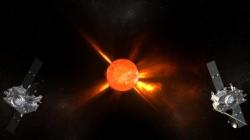A solar tsunami blasted its way through the sun’s lower atmosphere on May, 19 2007, and the action was captured by the twin STEREO spacecraft. Solar tsunamis are launched by huge explosions near the Sun’s atmosphere, called coronal mass ejections (CMEs). Although solar tsunamis share much in common with tsunamis on Earth, the solar version can travel at over a million kilometers per hour. Last year’s tsunami blasted and rolled for about 35 minutes, reaching peak speeds around 20 minutes after the initial flare. The observations were made by a team from Trinity College, Dublin.
“The energy released in these explosions is phenomenal; about two billion times the annual world energy consumption in just a fraction of a second. In half an hour, we saw the tsunami cover almost the full disc of the Sun, nearly a million kilometers away from the epicenter,” said David Long, a member of the team that made the observations.
STEREO’s Extreme Ultraviolet Imager (EUVI) instruments monitor the Sun at four wavelengths which correspond to temperatures ranging between 60,000 and 2 million degrees Celsius. At the lowest of these temperatures, scientists can see structures in the chromosphere, a thin layer of the solar atmosphere that lies just above the Sun’s visible surface. At temperatures between 1 and 2 million degrees Celsius, scientist can monitor features at varying levels in the solar corona.
The SOHO spacecraft, which was launched in 1995, also monitors the Sun at these wavelengths but only took images four times per day, giving scientists rare snapshots of these tsunamis. STEREO’s EUVI instruments take an image every few minutes to create a series, making it possible for scientists to track how the wave spreads over time.
Click here for a Quicktime animation of the event.
This is the first time that a tsunami has been observed at all four wavelengths, which enabled the team to see how the wave moved through the different layers of the solar atmosphere.
“To our surprise, the tsunami seems to move with similar speed and acceleration through all the layers. As the chromosphere is much denser than the corona, we’d expect the pulse there to drag. It’s a real puzzle,” said Dr. Peter Gallagher, another member of the team.
To complicate matters, the interval between images is not the same for all four cameras. At the time of the tsunami, the cameras monitoring radiation at 1 million degrees Celsius were set to take an image every 2.5 minutes. They recorded much higher speeds and accelerations for the wave than the other cameras, which were on 10 or 20 minute cycles. By taking a sample of one image in four, the data from these cameras matched the lower values observed in the other layers.
“We’ve thought for some time that the tsunamis might be caused by magnetic shockwaves but, in previous snapshots, the waves appeared to be travelling too slowly. However, we’ve seen from this set of observations that if the time interval between images is too long, it’s easy to underestimate the speed that the waves are moving. With a few more rapid-sequence observations of solar tsunamis, we should finally be able to identify the cause of these waves,” said Gallagher.
The discovery will be presented by David Long at the RAS National Astronomy Meeting in Belfast on Wednesday April 2, 2008.
For more information and animations, see Trinity College’s pageabout the solar tsunami.
Original News Source: RAS press release



While observing the cause of the these waves, astronomers should also try to find the effects it has on the solar system. For no action can have a null/void reaction.
Vanessa @ Future Trends in Astronomy